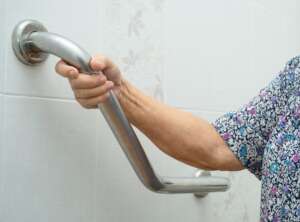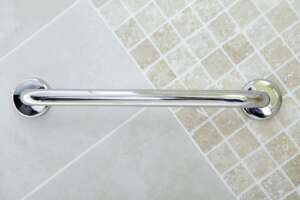The Best Places to Install Grab Bars and Handrails for Enhanced Safety
Proper installation of grab bars and handrails is essential for enhancing home safety, particularly for seniors and individuals with mobility issues. In this article, we’ll explore the best places to install these safety devices, such as bathrooms, staircases, and outdoor areas. We’ll also cover essential tips for installation, maintenance, and the role of occupational therapists in creating a safer environment.
Key Takeaways
- Installation of grab bars and handrails in critical areas, such as bathrooms and stairs, significantly enhances safety for seniors and individuals with mobility challenges.
- Proper selection and installation of grab bars and handrails, considering weight capacity, materials, and ADA compliance, ensure effective support and durability.
- Regular maintenance, inspections, and professional consultations with occupational therapists are essential to maintain the safety and functionality of grab bars and handrails.

Essential Grab Bars for Bathroom Safety
Bathrooms are one of the most dangerous areas in our homes, especially for seniors and individuals with medical issues. Grab bars provide stable support to prevent falls and tripping incidents in the bathroom for our loved ones.
Strategically placing these bars near the shower, tub, and toilet significantly enhances bathroom safety and provides the perfect solution for stability.
Shower Grab Bars
Shower areas are particularly hazardous due to wet, slippery surfaces. Grab bars inside the shower reduce the risk of slipping by providing a secure handhold. They offer stability while entering or exiting the shower, boosting confidence and reducing fall risks.
Grab bars in wet environments ensure users can navigate the shower area without fear of slipping.
Tub Grab Bars
Tub grab bars prevent falls by offering support when entering and exiting the bathtub. These bars should be positioned to help secure balance while stepping in and out of the bathtub, providing a stable point of contact that helps prevent accidents.
Strategically placed grab bars ensure necessary extra support where most needed.
Toilet Grab Bars
Grab bars around toilets make a significant difference. They offer stable support when transitioning to and from a seated position.
Flip-up toilet grab bars, which can be retracted against the wall, are particularly useful as they reduce strain on wrists and provide support without occupying much space. They ensure users can move safely and independently.

Handrails: Enhancing Home Accessibility in New Haven County, CT
Handrails enhance home accessibility by providing support and stability, especially for seniors and individuals with mobility challenges. They are particularly useful for navigating stairs and ramps. They help on uneven surfaces, reducing the risk of falls and accidents.
Handrails come in various finishes and styles, allowing you to choose options that match your home’s aesthetic while ensuring safety.
Staircase Handrails
Staircase handrails prevent falls and ensure safety, especially for seniors. Properly installed handrails provide a secure grip that helps individuals maintain balance while ascending or descending stairs. Handrails increase user confidence on stairs, reducing the likelihood of accidents.
Ensure handrails are on both sides of the staircase for maximum safety.
Hallway Handrails

Handrails in hallways provide ongoing support, helping seniors maintain balance while walking. They enhance balance and reduce fall risks.
Hallway handrails ensure older adults can walk safely without losing balance, making the home more accessible and safer.
Outdoor Step Handrails
Handrails on outdoor steps ensure safe navigation and reduce fall risks. They help seniors navigate uneven surfaces, minimizing the risk of tripping.
Outdoor handrails prevent accidents when navigating steps outside, especially in varying weather conditions.
Choosing the Right Grab Bars and Handrails
Selecting the right grab bars and handrails involves individual needs, styles, and intended installation locations. Recommendations from occupational therapists cater to specific needs, promoting safer environments.
Consider material, finish, weight capacity, and ADA compliance when choosing these safety aids.
Material and Finish Options
Grab bars come in various materials including stainless steel, brass, and plastic, allowing them to complement different bathroom decors. Rust-proof stainless steel grab bars are ideal for wet environments, ensuring durability and safety. Decorative finishes like chrome, brass, and bronze can be chosen to blend with existing bathroom decor while still providing safety.
Materials and finishes that match your home’s decor enhance aesthetic appeal without compromising safety.
Weight Capacity and Durability
Weight capacity ensures grab bars can safely support users without risk of failure. The minimum weight capacity of ADA-compliant grab bars is 250 lbs per bracket. Durability ensures that grab bars can withstand consistent use over time, maintaining safety.
Grab bars with appropriate weight capacity and durability provide necessary support and stability.
ADA Compliance
ADA-compliant grab bars meet safety standards and provide necessary support for users with mobility challenges. These grab bars are designed to meet safety standards, ensuring reliable support for individuals with disabilities.
Prioritize ADA compliance and user-specific needs for optimal safety. Professional installation ensures better adherence to safety standards compared to DIY methods.
Installation Tips for Grab Bars and Handrails
Proper installation ensures the safety and effectiveness of grab bars and handrails. Anchor grab bars to wall studs or use recommended mounting anchors for secure installation.
Install grab bars at a height between 33 and 36 inches from the floor for optimal support. This height ensures maximum effectiveness and safety. Place grab bars near showers, tubs, and toilets to maximize accessibility and safety.
Proper Placement
Proper placement of grab bars and handrails enhances safety by providing support and stability in critical areas, reducing fall risks. Install grab bars near showers, bathtubs, and toilets to assist with balance and stability in bathrooms.
Install handrails along staircases and in hallways to provide continuous support and reduce fall risks. Outdoor step handrails ensure safe navigation on outdoor steps and pathways, particularly for seniors and individuals with mobility issues.
Consider user height and the angle of installation to ensure maximum reach and accessibility when installing grab bars and handrails.
Maintaining Your Grab Bars and Handrails
Regular upkeep ensures grab bars continue to provide safety and support. Consistent maintenance ensures their longevity and safety.
Regular maintenance ensures grab bars and handrails remain safe and functional for elderly users. Consistent maintenance prevents accidents and ensures longevity.
Regular Inspections
Frequent checks on grab bars help identify any wear or potential hazards early. Check for signs of corrosion or looseness to prevent accidents and ensure reliability. Regular inspections identify any deterioration or damage that might compromise safety.
Regular inspections maintain the safety and reliability of grab bars and handrails.
Cleaning and Care
Use non-abrasive cleaners and avoid harsh chemicals to preserve the finish and functionality of grab bars and handrails. Mild soap and water effectively clean grab bars, while harsh chemicals can damage their finish.
Cleaning grab bars to remove soap scum and residues maintains their slip-resistant properties. Appropriate cleaning solutions and techniques preserve the appearance and performance of grab bars and handrails.
Addressing Issues Promptly
Regular inspections identify signs of wear, damage, or rust that could compromise safety. Address loose fittings or rust immediately to ensure user safety.
A regular cleaning and care routine maintains functionality and extends the lifespan of grab bars and handrails.
The Role of Occupational Therapists in Home Safety
Occupational therapists assess home environments to ensure safety and accessibility for individuals. They conduct evaluations to identify safety hazards and areas needing modifications for better accessibility.
Recommendations and modifications from occupational therapists enhance the overall safety of the home environment.
Home Assessments
Occupational therapists assess home environments to identify potential hazards and recommend modifications for improved safety and accessibility. They offer personalized recommendations for grab bars and handrails based on individual needs and home layout.
Occupational therapists provide follow-up support to ensure safety measures remain effective over time.
Personalized Recommendations
Home assessments by occupational therapists identify potential hazards and specific needs, informing the installation of grab bars and handrails. Choosing the right grab bars and handrails involves considering the user’s physical abilities, installation locations, and design preferences.
Personalized recommendations lead to effective safety modifications that reduce the risk of falls and enhance home safety, providing a simple solution.
Follow-Up Support
Occupational therapists enhance home safety by providing ongoing support and recommendations for effective safety measures. They conduct comprehensive home assessments to identify hazards and recommend modifications to improve safety.
Personalized recommendations help individuals select appropriate grab bars and handrails based on unique needs and home conditions. Follow-up support ensures safety solutions remain effective and adapt to changing needs over time.
Contact Oakley Home Access
In summary, installing grab bars and handrails in strategic locations around your home is essential for enhancing safety and preventing falls, particularly for seniors and individuals with mobility challenges. From bathrooms to staircases and outdoor steps, these fixtures provide the necessary support to navigate daily activities safely. Choosing the right materials, ensuring proper installation, and maintaining them regularly are key to their effectiveness. Occupational therapists can offer invaluable guidance and personalized recommendations to ensure your home remains a safe haven.
At Oakley Home Access, our team of home safety experts is dedicated to enhancing your quality of life through our passion for aging in place, fall prevention, and home accessibility. Owned and operated by registered, licensed CAPS certified contractors and occupational therapists, we provide comprehensive solutions tailored to your needs. Contact us today to learn how we can help make your home a safer and more accessible environment for you and your loved ones.
Frequently Asked Questions
Why are grab bars important for bathroom safety?
Grab bars are essential for bathroom safety because they offer reliable support, significantly reducing the risk of falls and injuries, especially for seniors and those with mobility challenges. Their installation can greatly enhance confidence and stability in a potentially hazardous environment.
Where should I install grab bars in the bathroom?
Grab bars should be installed near showers, bathtubs, and toilets to enhance safety and support. Ensuring they are strategically placed in these areas will significantly aid in maintaining balance and stability.
What materials are best for grab bars?
The best materials for grab bars are stainless steel, brass, and plastic, with rust-proof stainless steel being particularly suitable for wet environments. This ensures durability and safety in usage.
How do I ensure the grab bars are installed correctly?
To ensure grab bars are installed correctly, secure them to wall studs or use appropriate mounting anchors, and position them at a height of 33 to 36 inches from the floor. This will provide the necessary safety and support.
What role do occupational therapists play in home safety?
Occupational therapists play a crucial role in enhancing home safety by assessing environments for hazards and recommending modifications, such as the installation of grab bars and handrails, to promote accessibility and reduce the risk of injury.
